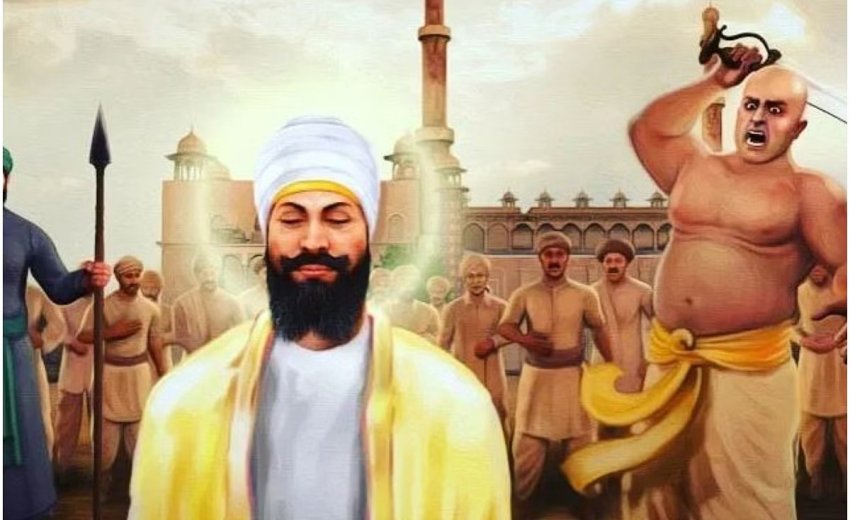The martyrdom of the ninth Sikh Guru, Tegh Bahadur, holds great significance in the Sikh religious calendar, and Sikhs worldwide .Devotees gather in large processions, and sing Kirtans to honour the Guru.Sermons and lectures are also organized.
Jaspal Kaur, the Chairperson of the Department of Guru Nanak Studies at Panjab University, elucidated, "The name 'Tegh Bahadur' translates to 'master of the sword,' signifying mastery over the spiritual rather than the political realm." The Guru consistently advocated, "be bold and fearless with others but not God." Amarjit Singh Kang, a distinguished professor in the Department of Sikh Studies at Kurukshetra University, added, "Born on April 1, 1621, in Amritsar, the guru was the youngest of five sons of the sixth guru Guru Har Gobind."
Early years
Tiyag Mal, known later as Guru Tegh Bahadur, actively participated in battles alongside his father. Impressed by his courage, his father bestowed upon him the title 'Brave of the Sword' - Tegh Bahadur. Guru Har Gobind introduced the concept of Miri (the political sword) and Piri (the spiritual sword), symbolized by the two swords he carried.
Guru Tegh Baghadur introduced a three-fold doctrine of Naam, Dan, and Isnaan.
Naam, the act of meditation on Waheguru, emphasizes simplicity and inner reflection, while Daan encourages the practice of sharing one's earnings.Isnaan is the act of bathing before morning prayers. Those who embrace these principles aim to transcend material desires. Guru Tegh, guided by his father's counsel, embarked on a 25-year meditative journey in Bakaala village until 1665 AD, eventually receiving the mantle of Guruship. His travels led him to Bengal and Assam, with a noteworthy stop in Patna, where his son 'Gobind Rai' was born. It's said that the guru once acted as a peacemaker, skillfully resolving a conflict between two rival kings in Assam, thus preventing bloodshed.
Pivotal role in propagating Sikhism
About five years later, he returned to Punjab and established Anandpur Sahib. Aurangzeb was known as one of the most ruthless and feared monarchs, reigning over India for more than five decades. The cruel ruler had imprisoned his sister, Shah Jahan (his own father), and executed his siblings to ascend to the throne. He strategically portrayed himself as a devout Muslim to enhance his public image. To gain favour with his Muslim followers, he forcefully converted Hindus to Islam, resorting to beheading those who resisted.
Aurangzeb, in his pursuit of converting Hindus to Islam, targeted the Southern states, such as Bengal, Bihar, Rajasthan, and Gujarat. He also initiated a systematic effort to convert high-caste Brahmins in Kashmir. In 1674 AD, the Kashmiri Brahmins sought refuge with Guru Tegh Bahadur, pleading for protection from Aurangzeb's oppressive measures. The guru made a noble decision to sacrifice himself to put an end to this cruel practice, designating his son as the next leader of the Sikhs.
In 1675 AD, Guru Tegh Bahadur faced arrest in Agra, accompanied by a few of his followers, and was transported to Delhi. There, he encountered pressure to convert to Islam and demonstrate miraculous abilities. Responding with grace, the guru maintained that an individual has the right to choose their religion and that performing miracles runs counter to God's will and the laws of nature. Fearless of death, he was resolute in his readiness to meet any consequence.
The Guru found himself locked within an iron cage, bearing witness to a dreadful sight. Before his eyes, three of his devoted followers met a tragic end.
The first follower was gruesomely sliced in half using a saw, secured between wooden planks. Another met a scalding fate, submerged in boiling water, while the third was consumed by flames within cotton wool. These devoted Sikhs willingly offered themselves as sacrifices, facing the Guru without hesitation or regret. Nevertheless, the Guru remained resolute. In 1675 AD, at the very spot where Gurdwara Sis Ganj Sahib in Delhi now stands, the Guru met his end when he was beheaded.
In the legacy of Guru Tegh Bahadur, his sacrifice remains a testament to unparalleled courage and unwavering compassion. His martyrdom continues to resonate with Sikhs worldwide, symbolizing the enduring fight for religious freedom and the timeless values of humanity.
*Based on an article by Arun Sharma, published in the Times of India on 24th November 2009
